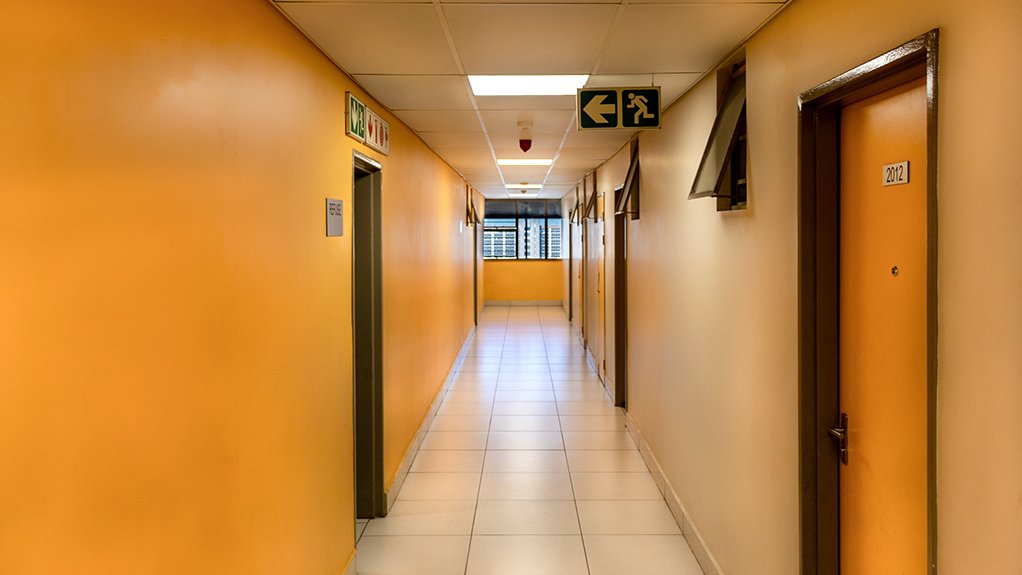Lighting provider upgrades two buildings


LIGHT AT THE END OF THE TUNNEL A lighting solution has been installed by Infinite Blue Energy at two older buildings in the Johannesburg CBD
Lighting solutions provider Infinite Blue Energy (IBE) has successfully completed the conversion of outdated lighting solutions to new energy efficient lighting technologies at two older buildings in the Johannesburg central business district, in Gauteng.
IBE operates as a turnkey solutions provider, and was responsible for the audit, supply and installation of over 1 970 light-emitting diode (LED) lighting units across both sites.
The two projects covered both buildings’ common areas, and the supply and installation of the lights took about six weeks.
“Collectively, the projects are estimated to save more than 950 000 kWh of electricity a year, under normal operating conditions,” says IBE CEO Mitch John.
A preliminary analysis of the client’s post-installation electricity consumption indicates savings in line with IBE’s pre-installation projections.
“We will continue to monitor the installation, as a long-term analysis is required to provide definitive positive results,” he adds.
Both buildings have back-up generators during loadshedding, which run most of the common-area lights within each building.
The LED lights are not only saving substantial electricity and associated costs during normal operating hours but are also reducing diesel consumption significantly during power outages and loadshedding.
“The cost of using diesel generators is estimated at an average of R8/kWh which, in some instances, is more than four times that of standard municipal rates.”
Mitch John explains the diesel consumption cost reduction equates to the reduction in electricity consumption of the new energy-efficient lighting versus that of energy-inefficient legacy lighting technology
He adds that a 5 W LED light would use about 50% less electricity than an older technology 10 W unit.
“Effectively, the electricity consumption of a 5 W light would cost about half that of a 10 W light at whatever the applicable kWh tariff rate might be,” he adds.
John adds that energy savings and return on investment (RoI) on LED installations, such as this one, are gradually improving, owing to the current state of South Africa’s electricity infrastructure and the associated electricity costs.
Maintaining Standards
IBE business development head Kyle John says the company offers a maintenance service level agreement to all clients, should they wish to monitor and maintain their installations.
“Additionally, all IBE products are backed by a three-year guarantee and/or an extended two-year warranty,” he enthuses.
All IBE’s LED light fittings meet the requirements as specified by the South African Bureau of Standards, the National Regulator for Compulsory Specifications and South African National Standards.
Moreover, all installation work is conducted by professionals registered with the Electrical Conformance Board of South Africa.
Importantly, all legacy light fittings and waste materials are disposed of in compliance with Occupational Health and Safety Act standards, says Kyle John.
Going Solar
Mitch John points out that although the company’s solar lighting solutions’ market share is relatively small, it has started to increase over the past few years, with promising orders being filled more regularly.
“One of the key aspects of our lighting proposals is that a reduction in lighting costs translates into a need for fewer solar photovoltaic panels and, therefore, associated costs,” he says.
Further, lighting electricity consumption – unlike many other forms of electricity consumption – is easily quantifiable, provable and verifiable.
“This enables us to be reasonably accurate in our projected savings estimates; this, in turn, means that our rand savings, RoI and payback period estimates are also fair assessments.”
Mitch John adds that a reduction in lighting consumption in an area – and especially with the installation of LED lighting – also effects a reduction in heating, ventilation, and air-conditioning (HVAC) costs, owing to lower temperatures in that area, a fact that is rarely mentioned.
“HVAC costs are usually the biggest electricity consumption expense in most buildings,” he comments, asserting that, therefore, the installation of LED lighting significantly reduces electricity consumption in two core areas.
Comments
Press Office
Announcements
What's On
Subscribe to improve your user experience...
Option 1 (equivalent of R125 a month):
Receive a weekly copy of Creamer Media's Engineering News & Mining Weekly magazine
(print copy for those in South Africa and e-magazine for those outside of South Africa)
Receive daily email newsletters
Access to full search results
Access archive of magazine back copies
Access to Projects in Progress
Access to ONE Research Report of your choice in PDF format
Option 2 (equivalent of R375 a month):
All benefits from Option 1
PLUS
Access to Creamer Media's Research Channel Africa for ALL Research Reports, in PDF format, on various industrial and mining sectors
including Electricity; Water; Energy Transition; Hydrogen; Roads, Rail and Ports; Coal; Gold; Platinum; Battery Metals; etc.
Already a subscriber?
Forgotten your password?
Receive weekly copy of Creamer Media's Engineering News & Mining Weekly magazine (print copy for those in South Africa and e-magazine for those outside of South Africa)
➕
Recieve daily email newsletters
➕
Access to full search results
➕
Access archive of magazine back copies
➕
Access to Projects in Progress
➕
Access to ONE Research Report of your choice in PDF format
RESEARCH CHANNEL AFRICA
R4500 (equivalent of R375 a month)
SUBSCRIBEAll benefits from Option 1
➕
Access to Creamer Media's Research Channel Africa for ALL Research Reports on various industrial and mining sectors, in PDF format, including on:
Electricity
➕
Water
➕
Energy Transition
➕
Hydrogen
➕
Roads, Rail and Ports
➕
Coal
➕
Gold
➕
Platinum
➕
Battery Metals
➕
etc.
Receive all benefits from Option 1 or Option 2 delivered to numerous people at your company
➕
Multiple User names and Passwords for simultaneous log-ins
➕
Intranet integration access to all in your organisation


















